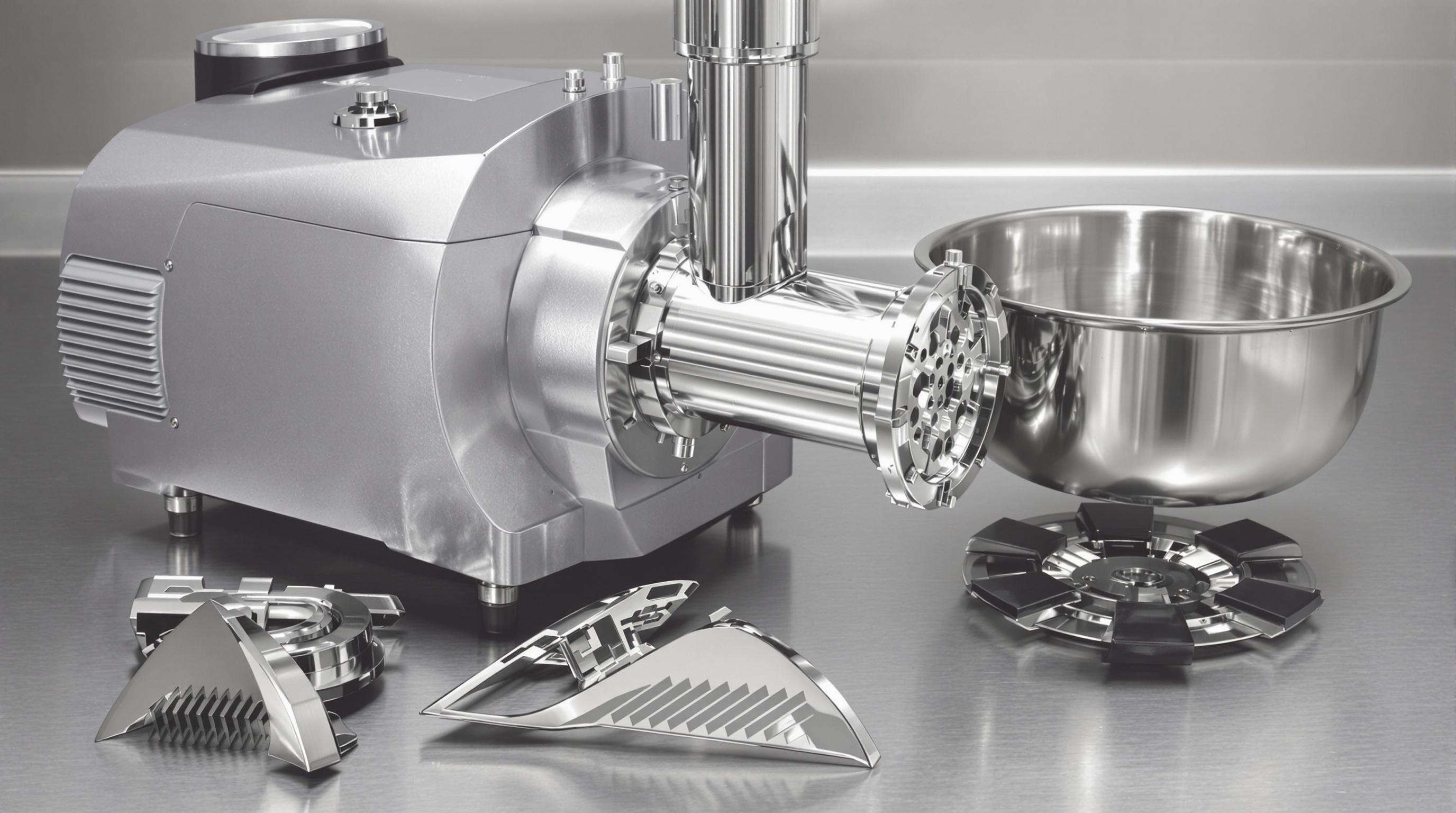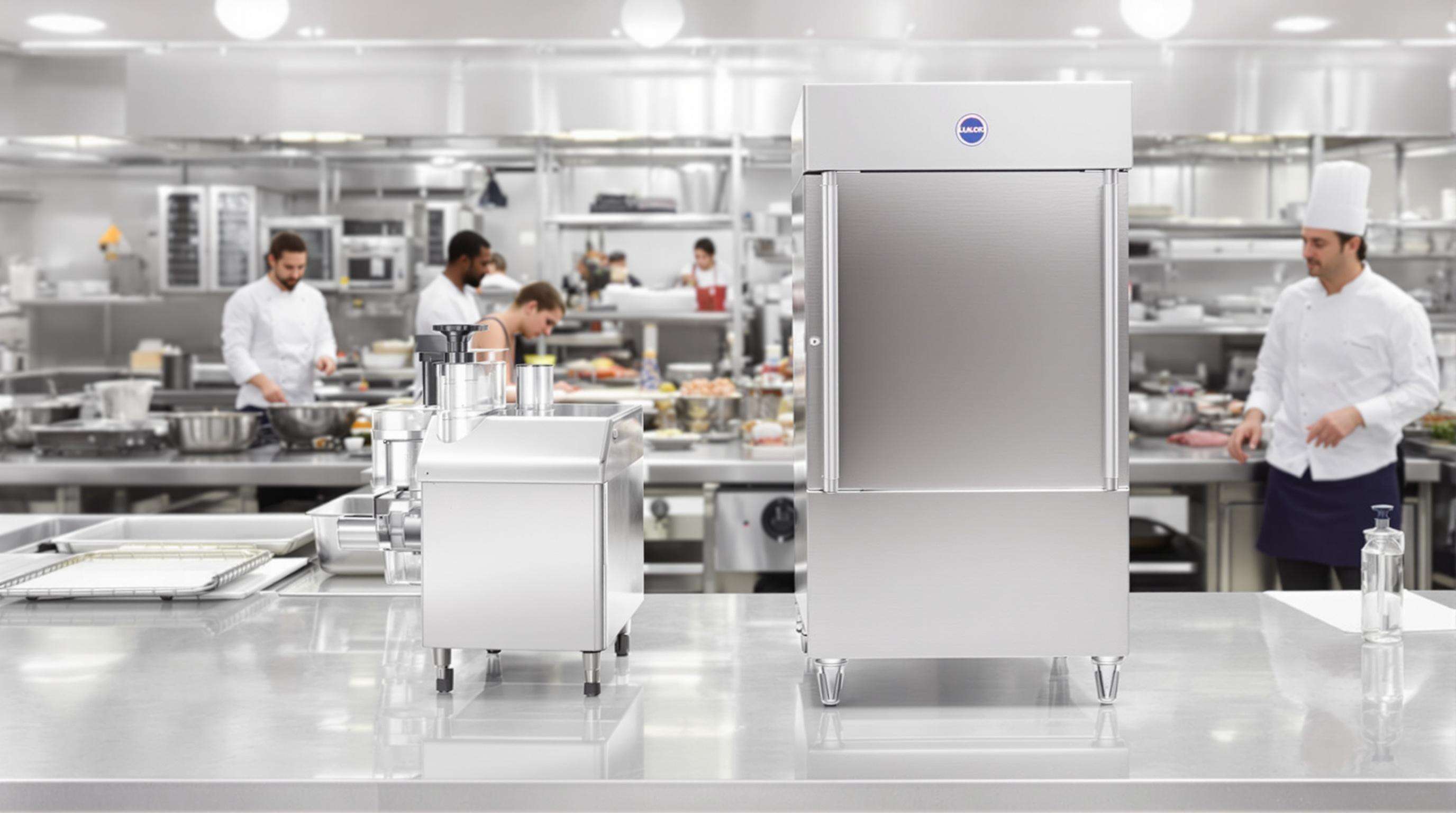Understanding Key Features of a Meat Chopper Machine

Essential Components: Motor, Bowl, and Blade System
All good commercial meat choppers depend on three main parts working together properly. First there's the motor, which needs to be strong enough to handle constant use. Then comes the stainless steel bowl, usually holding somewhere between 8 and 20 quarts depending on what model someone buys. The size of this bowl basically tells how much meat can be chopped at once. And finally, no machine would work right without proper blades. How those blades are shaped makes a big difference in whether everything gets cut evenly or ends up uneven. Most machines come with motors rated around 1,000 to 1,500 watts these days. These kinds of motors stay cool even when running all day long, which is why restaurants and butcher shops prefer them for their busy operations where downtime isn't an option.
Blade Quality and Material for Consistent, High-Volume Processing
Blades made from stainless steel that have a Rockwell hardness rating over 55 HRC stay sharp for well over 100 hours of continuous operation. When meat processing plants switch to interlocking blade setups instead of single blades, they typically see around a 30% drop in particle size differences. This matters a lot when making sausages or preparing emulsified meats where consistency is key. Many top equipment makers now incorporate cryogenic tempering into their manufacturing process. This treatment not only makes the blades last longer but also helps them resist rust better, something plant managers appreciate during long production runs.
Motor Power and Performance for Reliable Commercial Use
| Feature | Entry-Level (1,000W) | Heavy-Duty (1,500W+) |
|---|---|---|
| Batch Capacity | 15 lbs/hour | 45-60 lbs/hour |
| Duty Cycle | 20 minutes on/off | Continuous operation |
| Energy Use | 1.3 kWh | 2.1 kWh |
High-torque motors with copper windings maintain ±2% speed consistency under load, crucial for delicate preparations like pâtés. Built-in thermal cutoff switches prevent damage during extended use, supporting reliable performance across eight-hour shifts.
Manual vs Electric Meat Chopper Machines: Which Suits Your Operation?
Electric models are used in 85% of commercial kitchens due to hands-free operation and triple the throughput of manual units. However, manual crank choppers still serve specialty butchers who require fine texture control for small batches under 5 pounds. Key factors include:
- Labor costs: Electric units save 1.5 labor hours per 50 lbs processed
- Energy efficiency: Variable-speed electric models reduce annual power costs by $240 (DOE 2023)
- Maintenance: Electric gearboxes need quarterly lubrication, while manual units require annual upkeep
Hybrid systems with foot-operated starters offer a balance for charcuterie specialists needing both power and tactile precision.
Matching Capacity and Size to Your Business Needs

Grinding volume and throughput requirements for commercial kitchens
According to Food Service Equipment Report from 2023, commercial kitchens typically handle anywhere between 200 to 800 pounds of meat every single hour. That means kitchen managers need chopper machines that can actually keep up with this kind of workload. Banquet halls and other high volume spots really need something that can do over 500 lbs per hour at least. The little neighborhood deli? Something around 50 to maybe 150 lbs an hour works just fine for them most days. Getting the right capacity matters a lot because when busy times hit or there's a big catering order coming in, nobody wants their workflow slowing down due to equipment limitations. It just makes sense to match what the machine can do with what the kitchen actually needs.
Countertop vs floor-standing models: space and power considerations
| Feature | Countertop Models | Floor-Standing Models |
|---|---|---|
| Average Power | 1.5-3 HP | 5+ HP |
| Footprint | 2-4 sq. ft. | 6-10 sq. ft. |
| Ideal For | Limited-space prep areas | Industrial kitchens |
Full-service restaurants often select floor-standing units for their 360° access and powerful motors, while food trucks favor countertop models for portability and compatibility with standard 120V outlets.
Scaling meat chopper machine size to restaurant, deli, or butcher shop demand
When dealing with whole animal carcasses, butchers generally need feed tubes at least 3 inches in diameter with processing capacities over 800 pounds per hour. Pizza places that mix ground sausage meat work just fine with smaller to medium sized equipment though. For businesses running multiple locations, going standardized makes sense. Take this regional burger joint for instance they installed the same 300 lb/hour machines in all their 12 stores and saw an 18 percent drop in staff training expenses according to the Chain Restaurant Efficiency Report from last year. Consistent gear means less time spent teaching different systems and smoother day to day operations across the board.
Prioritizing Durability and Safety in Commercial Equipment
Stainless Steel Construction and Long-Term Durability of Meat Chopper Machines
Commercial chopper machines use corrosion-resistant materials to endure daily sanitation and acidic residues. Stainless steel—particularly 400-series alloys—lasts 3 to 5 times longer than aluminum in high-moisture environments. This construction resists bacterial growth and withstands over 200 wash cycles annually without degradation, meeting long-term durability standards in professional kitchens.
Commercial-Grade Engineering for Continuous Operation
Top-tier units feature motors rated for up to 16 hours of daily use, supported by industrial bearings and thermal overload protection. Machines built for delis and butcher shops often undergo rigorous stress testing, including 10,000-hour endurance trials under maximum load. This engineering reduces downtime by 40-60% compared to consumer-grade alternatives.
Integrated Safety Features to Protect Operators and Ensure Compliance
Today's commercial choppers come equipped with multiple safety features including those magnetic bowl locks that have kept accident rates at just about 99.9% according to recent FDA inspections. The emergency stop buttons activate within half a second or less, giving operators quick response time when needed. For NSF certified units, they already cover around 70% of local food safety requirements out of the box. And don't forget about those blade guards either. They've been put through rigorous testing and can handle impacts from objects weighing up to fifty pounds. That kind of durability makes all the difference when running long shifts with heavy production volumes.
Enhancing Productivity Through Performance and Versatility
Efficiency gains: uniform results, reduced prep time, and labor savings
Commercial meat chopper machines reduce prep time by 30-50% compared to manual methods (2023 foodservice efficiency studies). Their consistent output minimizes waste from uneven cuts, enabling kitchens to reallocate 8-12 labor hours weekly to revenue-generating tasks—all while maintaining strict portion control.
Interchangeable blades and adjustable speeds for diverse meat preparations
High-end units typically include 4 to 6 blade types, from coarse 8mm plates for burgers to fine 3mm discs for emulsified sausages. Variable-speed controls (800-3,200 RPM) allow adaptation across poultry, beef, and game meats without compromising texture. These stainless steel blades maintain performance over 10,000 cycles in USDA-approved systems.
Multi-functional use: mincing, grinding, and emulsifying with one machine
Top-performing choppers handle 98% of meat prep tasks—grinding up to 400 lbs/hour for burgers, emulsifying 220 lbs/hour for hot dogs, and mincing 350 lbs/hour for tacos. Consolidating functions reduces equipment costs by $18,000-$25,000 compared to purchasing specialized machines, while unified bowl and blade systems cut cleaning time by 35%.
Streamlining Maintenance and Cleaning for Daily Use
Design features that simplify cleaning and reduce downtime
Chopper machines with removable blade assemblies, rounded edges, and seamless stainless steel surfaces reduce cleaning time by 30-50%. Quick-release levers for bowl detachment and one-piece blade housings eliminate crevices where debris can accumulate, ensuring compliance with NSF/ANSI 3 sanitary standards.
Dishwasher-safe components vs manual cleaning: balancing convenience and cost
While 65% of operators prefer dishwasher-safe bowls and accessories (Food Service Equipment Journal 2023), hand-washing can extend component life. Consider:
- Dishwasher-safe models: Carry a $200-$500 premium but save 15 minutes in daily labor
- Manual-clean units: Use durable cast stainless parts requiring 6-8 minutes of hand washing per shift
Units with grease-resistant motors and antimicrobial handle coatings maintain hygiene with minimal scrubbing, further streamlining daily maintenance.
FAQ Section
-
What are the main components of a meat chopper machine?
A meat chopper machine comprises a powerful motor, a stainless steel bowl, and blade systems designed for consistent cutting.
-
Why is stainless steel favored for blades and construction?
Stainless steel offers superior durability, resists rust, and maintains hygiene standards essential for commercial kitchens.
-
What advantages do electric meat chopper machines offer?
Electric machines offer hands-free operation, higher throughput, energy efficiency, and reduced labor costs.
-
What capacity should one choose based on business needs?
The choice of capacity should match the amount of meat processed. Large-scale operations require higher capacities to avoid workflow disruptions.
-
Are dishwasher-safe components worth the investment?
Dishwasher-safe components save cleaning time, but manual cleaning can extend the lifespan of parts.

